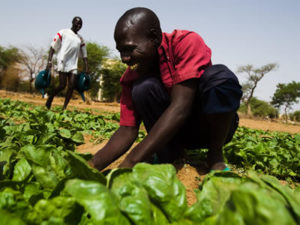
A few years ago, many of the dishes at K’Osewe would have included kale or collard greens. These vegetables came to Africa from Europe just over a century ago. Indigenous vegetables were mainly sold to the citizens of Nairobi in specialized markets. Many of Africa’s rural communities enjoy these vegetables on a regular basis. However, indigenous vegetables weren’t given much attention by researchers and seed companies, which is why they lag behind in commercial crops in terms of quantity and quality.
These days, native vegetables are an ever-growing food trend. Many of the major supermarkets in Nairobi carry them and seed companies are now breeding more traditional variety of vegetables every year. Farmers in Kenya have increased the area with which they plant greens by 25 percent between 2011 and 2013. People all over East Africa are also realizing the health benefits of these vegetables, which is why these crops have increased significantly.
What This Means For Nutrition In Africa and Beyond
The news of Kenya’s native crops being restored is positive, particularly in the eyes of nutrition experts and agricultural researchers. These professionals state that indigenous vegetables have a number of health benefits, including being richer in vitamins, iron, protein and other essential nutrients that protect against dietary deficiencies. Mary Abukutsa-Onyango, a horticultural researcher at Jomo Kenyatta University of Agriculture and Technology in Juja, Kenya, is a major supporter of Kenyan crops.
In Africa, malnutrition is such a problem,” she says. “We want to see indigenous vegetables play a role.”
African scientists are increasing their study of indigenous vegetables to get a full understanding of their benefits, and are improving the crops through breeding experiments. It is the hope that these research efforts will put the vegetables in greater demand with both customers and farmers. However, there is a downside to experimentation. As indigenous vegetables become more widespread, researchers looking for crops that grow faster may breed out the disease-resistant traits and other characteristics traits that make the plants so beneficial.
Andreas Ebert, a gene-bank manager at the World Vegetable Center (AVRDC), a research center for agriculture based in Shanhua, Taiwan, says it’s important to be careful about this tendency.
“It is important that when we promote a specific crop, the we try to come up with different varieties,” he says.
He shares that if making these vegetables more popular limits the choices consumers have, “the major benefits we are currently seeing will be lost.”
Specific Benefits of Kenyan Vegetables
Kenyans especially favor East African leafy greens. They are almost all a rich green color and have a bitter taste. Spider plant, African nightstade and amaranth leaves are among these greens. Spider plant is known for its sour taste, and Jute mallow, which is also popular in the region, has a slimy texture when cooked that people either hate or love. Jute mallow is one of Kenya’s most nutritious vegetables, has medicinal benefits, and is commonly grown in several parts of the world. Research also shows that amaranth greens, spider plant and African nightshade are high in antioxidants such as vitamins A, C, and E, and also contain high amounts of folate and calcium.
Diversity in Crops and Culture
Now that these indigenous vegetables are grown in greater amounts, researchers say that it will be difficult to prevent the less common varieties of vegetables from becoming a thing of the past. This could threaten the rate at which crops are thriving, because different vegetable varieties carry different genes that carry resistance to insects, pests and pathogens. Diversity is also essential to maintain the appeal of these vegetables. For example, in Kenya, the communities along the coast tend eat giant African nightstade, whereas the Western areas of the country prefer the smaller variety.
Researchers like Abukutsa often visit the university campus to look at some of the work of the students there. One student has spread amaranth leaves in a box in direct sunlight to see how drying the leaves will affect the nutritional value of the vegetable. Abukutsa also talks to another student who is standing around rows of African nightstade plants to study the vegetables for an experiment on the genetic diversity of the plants.
“We’ve come so far,” she says, “but there’s still so much to be done.”


